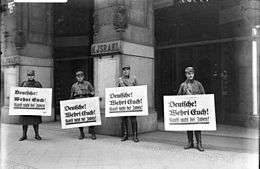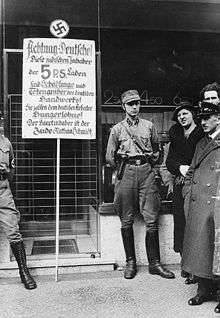Nazi boycott of Jewish businesses


The Nazi boycott of Jewish businesses in Germany began on April 1, 1933, and was claimed to be a defensive reaction to the Jewish boycott of German goods,[1][2] which had been initiated but quickly abandoned in March 1933.[3] It was largely unsuccessful, as the German population continued to use Jewish businesses, but revealed the intent of the Nazis to undermine the viability of Jews in Germany.[4]
It was the first governmental action against the Jews of Germany by the new National Socialist government, actions that culminated in the "Final Solution". It was a state-managed campaign of ever-increasing harassment, arrests, systematic pillaging, forced transfer of ownership to Nazi Party activists (managed by the Chamber of Commerce), and ultimately murder of owners defined as "Jews". In Berlin alone, there were 50,000 Jewish-owned businesses.[5]
Earlier boycotts
Antisemitism in Germany grew increasingly pervasive after the First World War and was most prevalent in the universities. By 1921, the German student union Deutscher Hochschulring barred Jews from membership. Since the bar was racial, it included Jews who had converted to Christianity.[6] The bar was challenged by the government, leading to a referendum in which 76% of the student members voted for the exclusion.[6]
At the same time, Nazi newspapers began agitating for a boycott of Jewish businesses, and anti-Jewish boycotts became a regular feature of 1920s regional German politics with right-wing German parties becoming closed to Jews.[7]
From 1931–32, SA Brownshirt thugs physically prevented customers from entering Jewish shops, windows were systematically smashed and Jewish shop owners threatened. During the Christmas holiday season of 1932, the central office of the Nazi party organized a nationwide boycott. In addition, German businesses, particularly large organizations like banks, insurance companies, and industrial firms such as Siemens, increasingly refused to employ Jews.[7] Many hotels, restaurants and cafes banned Jews from entering and the resort island of Borkum banned Jews anywhere on the island. Such behavior was common in pre-war Europe;[8][9] however in Germany, it reached new heights.
Anti-Nazi boycott of 1933

The Anti-Nazi Boycott of 1933 was a boycott of Nazi products by foreign critics of the Nazi Party in response to antisemitism in Nazi Germany following the rise of Adolf Hitler, commencing with his appointment as Chancellor of Germany on January 30, 1933. Those in the United States, the United Kingdom and other places worldwide who opposed Hitler's policies developed the boycott and its accompanying protests to encourage Nazi Germany to end the regime's anti-Jewish practices.
National boycott

In March 1933, the Nazis won a large number of seats in the German parliament, the Reichstag. Following this victory, and partly in response to the foreign Anti-Nazi boycott of 1933,[10] there was widespread violence and hooliganism directed at Jewish businesses and individuals.[6] Jewish lawyers and judges were physically prevented from reaching the courts. In some cases the SA created improvised concentration camps for prominent Jewish anti-Nazis.[11]
On April 1, 1933, the Nazis carried out their first nationwide, planned action against Jews: a boycott targeting Jewish businesses and professionals, in response to the Jewish boycott of German goods.
On the day of the boycott, the SA stood menacingly in front of Jewish-owned department stores and retail establishments, and the offices of professionals such as doctors and lawyers. The Star of David was painted in yellow and black across thousands of doors and windows, with accompanying antisemitic slogans. Signs were posted saying "Don't Buy from Jews!" (Kauf nicht bei Juden!), "The Jews Are Our Misfortune!" (Die Juden sind unser Unglück!) and "Go to Palestine!" (Geh nach Palästina!). Throughout Germany acts of violence against individual Jews and Jewish property occurred.
The boycott was ignored by many individual Germans who continued to shop in Jewish-owned stores during the day.[12][1]
International impact
The Nazi boycott inspired similar boycotts in other countries. In Poland the Endeks (founded by Roman Dmowski) organized boycotts of Jewish businesses across the country.[13]
In Quebec, French-Canadian nationalists organized boycotts of Jews in the 1930s.[14]
In the United States, Nazi supporters such as Father Charles Coughlin (a Canadian immigrant) agitated for a boycott of Jewish businesses. Coughlin's radio show attracted tens of millions of listeners and his supporters organized "Buy Christian" campaigns and attacked Jews.[15] Also, Ivy League Universities restricted the numbers of Jews allowed admission.[16][17]
In Austria, an organization called the Antisemitenbund had campaigned against Jewish civil rights since 1919. The organization took its inspiration from Karl Lueger, the legendary 19th-century antisemitic mayor of Vienna, who inspired Hitler and had also campaigned for a boycott of Jewish businesses. Austrian campaigns tended to escalate around Christmas and became effective from 1932. As in Germany, Nazis picketed Jewish stores in an attempt to prevent shoppers from using them.[18]
In Hungary, the government passed laws limiting Jewish economic activity from 1938 onwards. Agitation for boycotts dated back to the mid-nineteenth century when Jews received equal rights.[19]
Subsequent events
The national boycott operation marked the beginning of a nationwide campaign by the Nazi party against the entire German Jewish population.
A week later, on April 7, 1933, the Law for the Restoration of the Professional Civil Service was passed, which restricted employment in the civil service to "Aryans". This meant that Jews could not serve as teachers, professors, judges, or in other government positions. Most Jewish government workers, including teachers in public schools and universities, were fired, while doctors followed closely behind. However, the Jews who were war veterans were excluded from dismissal or discrimination (about 35,000 German Jews died in the First World War).[20] In 1935, the Nazis passed the Nuremberg Laws, stripping all Jews of their German citizenship, regardless of where they were born.[11] Also, a Jewish quota of 1% was introduced for the number allowed to attend universities. In the amendment published on April 11 of Part 3 of the law, which stated that all non-Aryans were to be retired from the civil service, clarification was given: "A person is to be considered non-Aryan if he is descended from non-Aryan, and especially from Jewish parents or grandparents. It is sufficient if one parent or grandparent is non-Aryan. This is to be assumed in particular where one parent or grandparent was of the Jewish religion".[21]
"Jewish" books were publicly burnt in elaborate ceremonies, and laws that clearly defined who was or was not Jewish were passed. Jewish-owned businesses were gradually forced to sell out to (non-Jewish) Germans.
After the Invasion of Poland in 1939, the German Nazi occupiers forced Jews into ghettos and completely banned them from public life. But even this was not enough for the Nazi Germans: by 1940, they had turned to genocide, resulting in what is now known as The Holocaust.
References
- 1 2 "Boycott of Jewish Businesses". Holocaust Encyclopedia. USHMM.
- ↑ The History Place (2 July 2016), “Triumph of Hitler: Nazis Boycott Jewish Shops”
- ↑ Berel Lang (2009). Philosophical Witnessing: The Holocaust as Presence. UPNE. pp. 131–. ISBN 978-1-58465-741-5.
- ↑ Pauley, Bruce F (Mar 1 1998), "From Prejudice to Persecution: A History of Austrian Anti-Semitism", University of North Carolina Press, pp 200-203
- ↑ Kreutzmüller, Christoph (2012). Final Sale – The Destruction of Jewish Owned Businesses in Nazi Berlin 1930–1945. Metropol-Verlag. ISBN 978-3-86331-080-6.
- 1 2 3 Rubenstein, Richard L.; Roth, John K. (2003). "5. Rational Antisemitism". Approaches to Auschwitz: the Holocaust and its legacy (2nd ed.). Westminster John Knox Press. pp. 123–124. ISBN 978-0664223533.
- 1 2 Longerich, Peter (2010). "1: Antisemitism in the Weimar Republic". Holocaust: The Nazi Persecution and Murder of the Jews (1st ed.). USA: Oxford University Press. ISBN 978-0192804365.
- ↑ Karpf, Anne (8 June 2002), “We've been here before”, The Guardian
- ↑ Encyclopedia.com (28 Sept 2008), “Pogroms”
- ↑ The Anti-Nazi Boycott of 1933, American Jewish Historical Society. Accessed January 22, 2009.
- 1 2 Michael Burleigh; Wolfgang Wippermann (1991). "4: The Persecution of the Jews". The Racial State: Germany, 1933-1945. Cambridge University Press. p. 77. ISBN 978-0-521-39802-2.
- ↑ "Boycott of Jewish Businesses". Jewish Virtual Library.
- ↑ Cang, Joel (1939). "The Opposition Parties in Poland and Their Attitude towards the Jews and the Jewish Question". Jewish Social Studies. 1 (2): 241–256.
- ↑ Abella, Irving; Bialystok, Franklin (1996). "Canada: Before the Holocaust". In Wyman, David S.; Rosenzveig, Charles H. The World Reacts to the Holocaust. The Johns Hopkins University Press. pp. 751–753. ISBN 978-0801849695.
- ↑ "Charles E. Coughlin". Holocaust Encyclopedia. USHMM.
- ↑ Horowitz, Daniel (1998). Betty Friedan and the Making of The Feminine Mystique: The American Left. p. 25.
- ↑ Karabel, Jerome (2005). The Chosen: The Hidden History of Admission and Exclusion at Harvard, Yale, and Princeton. Houghton Mifflin.
- ↑ Bruce F. Pauley, "From Prejudice to Persecution: A History of Austrian Anti-Semitism," (North Carolina, 1992), page 201.
- ↑ Randolph L. Braham, "The Christian Churches of Hungary and the Holocaust," Yad Vashem (Shoah Resource Center), pp. 1-2.
- ↑ "Law for the Restoration of the Professional Civil Service, April 7, 1933". www1.yadvashem.org. Retrieved 2015-10-27.
- ↑ "Documents on the Holocaust: Selected Sources on the Destruction of the Jews of Germany and Austria, Poland, and the Soviet Union," ed.by Arad, Yitzhak; Gutman, Yisrael; Margaliot, Abraham (Jerusalem: Yad Vashem, 1987), p.39-42.
External links
| Wikimedia Commons has media related to Nazi boycott of Jewish businesses. |
- United States Holocaust Memorial Museum - Boycott of Jewish Businesses
- Fritz Wolff Dismissal from Karstadt (1933) - 1933 Judenboykott